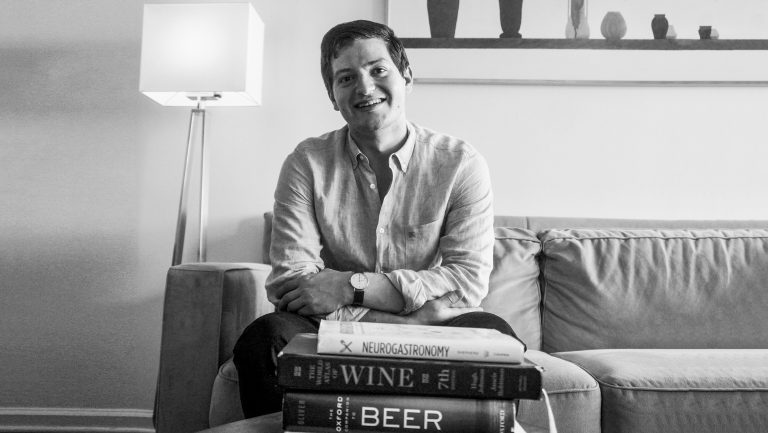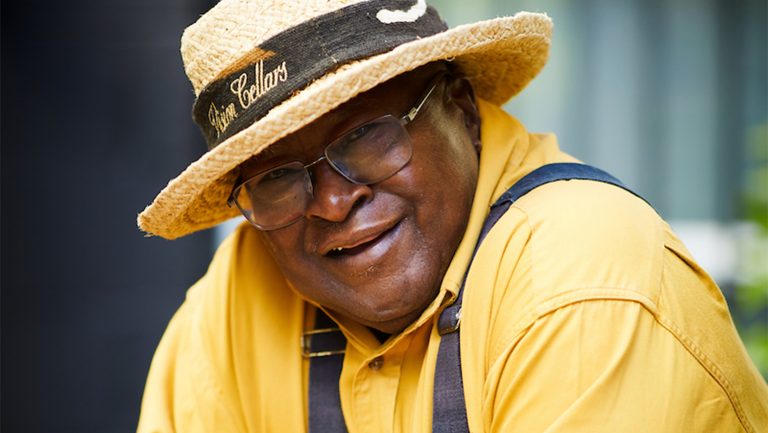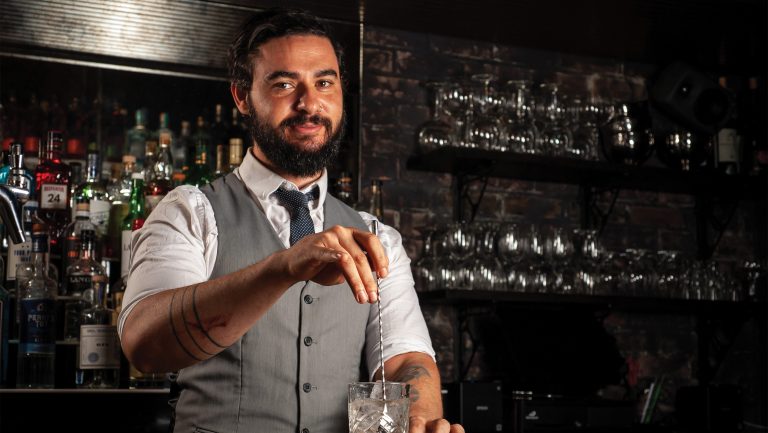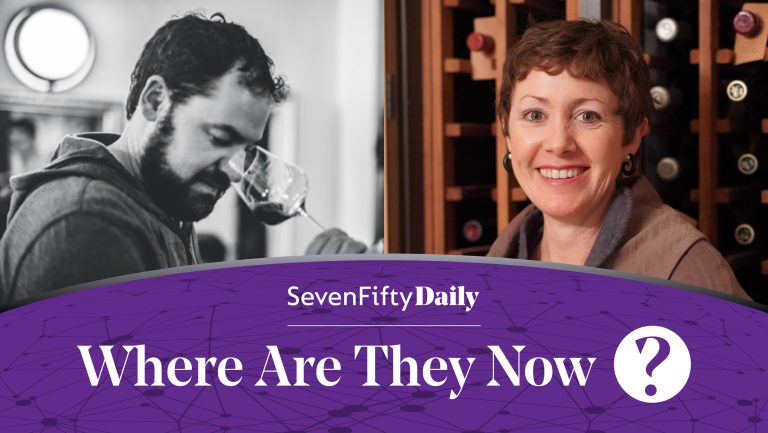One of gastronomy’s most favored pairings, cheese and wine, has found an ambassador in Jonathan Eichholz, a cheese microbiologist turned sommelier and cicerone, who in his short career has already sniffed out a love for all things fermented.
Though only 24, Eichholz, has already defined his path in food and wine, bolstered by a multidisciplinary background based in science. At Colby College in Waterville, Maine, he studied neuroscience with dreams of medical school, but a turn toward liberal arts coupled with a love for cheese shifted his interests.
“I took a class in Iranian history and realized—wait, there’s so much more to the rest of the world than studying brain surgery,” he says. At the same time, he was the gourmand in his dormitory, introducing his fellow residents to farmstand cheeses and French wines like Muscadet and white Rhône.

Don’t miss the latest drinks industry news and insights. Sign up for our award-winning newsletters and get insider intel, resources, and trends delivered to your inbox every week.
“When most of the others were drinking box wine or cheap beer, he would host wine and cheese parties—a really atypical experience for college students,” said Nick LaRovere, a former roommate. He recalled Eichholz as “always cooking in the kitchen and playing with flavors.”
Eichholz attributes that enthusiasm to the “let’s eat everything; let’s celebrate everything” philosophy of the Colombian, German, and Jewish household in which he grew up. Though his parents—first-generation Americans—migrated from Manhattan to Long Island (via Queens), he says they brought their inquisitive palates along with them.
But it was a summer internship at Murray’s Cheese that provided the consummate culinary geek-out experience: Eichholz worked in the shop’s state-of-the-art caves, monitoring and quarantining cheese molds.
“One of the really cool parts,” he says, “was the natural rind cave, where we kept everything that wasn’t washed or Alpined, and seeing how different molds grow on the cheeses, and how to prevent them or get different mold strengths off others.”
Spoken like a true scientist. Or cheese head.
Mornings were spent in the caves, and afternoons in pairing classes, where he learned that beer is sometimes the better pairing partner (a revelation that led him to get his cicerone certification). The culinary classroom provided a turning point.
“After Murray’s,” Eichholz says, “I realized food was really what I wanted to do, and I started focusing on a lot of academic studies about food.”
On returning to college, he studied the cross section of food, culture, history, and society. His thesis, “Terroir in the 21st Century: From Socio-History to Science,” which centered on the origin and production of Camembert, explained it all.
James R. Fleming, the Charles A. Dana professor of Science, Technology, and Society at Colby—and Eichholz’s thesis adviser—recalls him as “a culinary specialist … able to address history, culture, science, and trends in the industry. Jonathan did real crossover work between the cultural history of terroir and the scientific pressures to reverse-engineer traditional products in mass quantities.”
Eichholz’s last internship, at Proud Pour, a start-up in Boston with a charitable environmental focus, provided his official foray into wine, and the certainty that though science was a draw, hospitality was his calling.
“What I really missed,” he says, “was interacting with people.
“When I worked at Murray’s, everyone had finished their MBA or did their JD or went to medical school, and five years into it were like ‘This isn’t for me,’” Eichholz recalls. “I wanted to be in food. And I thought, Why not jump right into it instead of spending those years wishing I was doing something else.”
He landed his first job at an old-school American concept restaurant in Washington, D.C., that focused on French, Italian, and marquee Napa Valley wines. It was a good education, but, Eichholz notes, “One of my mentors said, ‘You have to learn the rules as a lawyer in order to break them like an artist.’”
After getting the basics of traditional pairings down, he moved to Garrison, a locavore restaurant on Capitol Hill, where a rotating menu of seasonal dishes gave him freedom to experiment with wines beyond the classics.
“I played with everything from aged Muscadet to Fazi Battaglia’s Passo Del Lupo from Conero DOCG in Le Marche,” he says, ”and really fun stuff.”
Ben Peres, Garrison’s general manager at the time, says he was impressed by Eichholz’s out-of-the-box thinking and his ability to understand how food and wine are cultivated, and taste, and then take the next step.
“I know a lot of people who are highly talented, but I haven’t really seen that melding of science and [taste],” Peres says. “He knew how all those taste factors fit together so that pairings would be a delight for guests.”
After two years in the capital, though, Eichholz says, he knew it was time to come home.
“I was ready to be where you had access to every wine in the world,” he says, “and the highest concentration of wine professionals.” He moved to New York at the beginning of this past summer, and quickly secured his current position at Aquavit in New York City.
“I was looking for a combination of mentorship and a place looking to expand, but at the same time was established with a really fun list to play with,” he says. “Aquavit just fit the bill for that.”
Of course, there’s that matter of pairing wines with Nordic cuisine, a chemical-compound challenge for many sommeliers.
Eichholz is not dissuaded, saying, “The really exciting part is how malleable the cuisine is. … You have fermented vegetables, you have meat and fish—you have everything.”
He works with Aquavit’s beverage director, Chris Clark, on list options including the classics and offerings from Jura and Vins de France, along with sake and beer—all in sync with the restaurant’s seasonal tasting menus.
A recent tasting menu started with sherry paired with cured Spanish mackerel, and a beverage progression that featured sake, a Mourvèdre rosé from Amador County, California, Gamay from Chateau du Moulin-à-Vent, and finally a Passito di Pantelleria from Sicily.
Eichholz’s current favorite coupling (which happens to roll off his tongue) is Philippe Bornard’s l’Ivresse de Noé, Vins de France from Pupillin in the Jura, a late-harvest Savagnin with two years in demi-muid, paired with butter-poached Norwegian king crab with charred leeks, cucumbers, and roasted garlic sauce.
Was it encyclopedic knowledge, collaboration, or taste memory that created such a specific pairing?
Eichholz says a combination of trial and error in tasting (he and Clark originally considered sake) led to the pairing but that ultimately he reached into his scientific kit bag for the answer.
“Science is very cause and effect,” he says, “with certain neurological responses elicited by what compounds are on the palate or going into the nose and being able to build tasting experiences off that,” he says.
Yep, we knew that.
Eichholz hopes to sit for the Court of Master Sommeliers’ advanced exam next year and has his sights set on the master accreditation.
Says Peres, his former manager, “He’s very highly driven, extremely studious in trying to advance his sommelier status, but what I think is important to him is not the status but moving up the ranks because he wants to further his own knowledge, and the more he takes in, the more he can impart to others.”

Dispatch
Sign up for our award-winning newsletter
Don’t miss the latest drinks industry news and insights—delivered to your inbox every week.
Lana Bortolot has written on food and wine for Forbes, Dow Jones, Wine Enthusiast, Saveur, and other magazines of the wine and spirits trade. She reported on real estate for the New York Times, Wall Street Journal, and New York Post, and on design for Entrepreneur magazine. She is a candidate for Wine & Spirit Education Trust’s Level 4 Diploma. Having covered most European wine regions and a few in South America, she is always looking to add a new wine-stained stamp to her passport.







